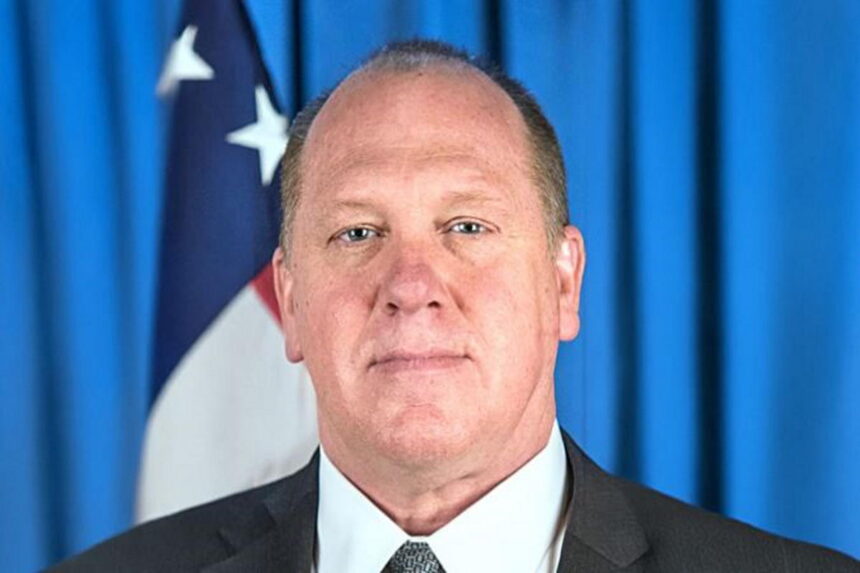On Sunday, President-elect Donald Trump named Tom Homan, a former acting director of U.S. Immigration and Customs Enforcement, or ICE, as his administration’s new “border czar.” Homan is considered a hardliner with some pretty strong stances on border control and was appointed to reinforce Trump’s pledge to address illegal immigration through aggressive enforcement measures.
Who is Tom Homan?
Thomas Douglas Homan was born on November 28, 1961, in West Carthage, New York. He is a retired American police officer and immigration official who worked his way up to become an Immigration and Naturalization Service agent in 1984 from a police officer.
Later, he joined the Immigration and Naturalization Service in 1984 and worked his way up through various positions, including Border Patrol agent and investigator. A meteoric rise through the ranks in immigration enforcement led him to be appointed as acting director of U.S. Immigration and Customs Enforcement under the Trump administration from January 30, 2017, to June 29, 2018.
Notorious under Homan’s inflexible stance on immigration policies, he was a loud voice in support of calls for the deportation of undocumented immigrants and against the policy of sanctuary cities. He later became a contributor at Fox News upon retirement from government service.
Throughout his career, Homan was known for radical opinions on immigration enforcement. In 2014, he had proposed separating children from their parents to deter illegal border crossings-a policy he would later be associated with, even though it was enacted by the Trump administration years later.
This hardline stance on immigration earned him the label of “intellectual father” of the family separation policy. Homan’s commitment to removal was rewarded in 2015 when he was granted a Presidential Rank Award by President Obama.
The Role and Responsibilities of the Border Czar
In a press release, Trump announced that Homan would be in charge of “all aspects” of the nation’s borders, including Southern and Northern borders, maritime security, and aviation safety. He is tasked with making America’s borders safe and being uncompromising in pursuing enforcement policies. Long a hardliner on immigration, Homan was front and center when the Trump administration was pushing to ramp up deportations and border enforcement.
“I have no doubt he will do a fantastic, and long-awaited job.” Trump wrote in a post on Truth Social. He underlined Homan’s wide experience in law enforcement and border security and emphasized that he was especially fit to lead the role of reducing illegal immigration and improving the nation’s border security infrastructure.
Homan’s Background and Immigration Record
Indeed, this Tom Homan announcement did not come as a surprise to those who know him from his service time as head of ICE. When he was in office, Homan was known for defending the Trump administration’s “zero tolerance” immigration policy.
This was an infamous stance that separated thousands of migrant families along the Southern Border blatant issue that the nation so heinously criticized. Trump changed it through an executive order in 2018 as the backlash got too hot to handle. But Homan has continued to defend the strategy behind opening up deportations, saying such a policy was doable “humanely” without sacrificing security.
Homan has made no secret throughout his career of his belief in mass deportations. He once vowed to lead “the biggest deportation force this country has ever seen.” His approach to immigration reform is based on the idea of enforcing laws that protect American citizens, in his view, against criminal elements entering the country illegally.
Homan’s no-nonsense attitude is not limited to family separations. In an interview with PBS back in 2018, Homan told the news organization that he thinks keeping families together through deportation is “hard” and “not practical.” As the quote above reveals, such thinking underlines his overall philosophy: strict enforcement of immigration laws is key to protecting national security and respect for the rule of law.
Critique of Sanctuary Policies and Greater Immigration Issues
The most durable theme of Homan’s career as a critic involves what is usually labeled “sanctuary cities”: cities that limit the amount of cooperation extended to federal immigration authorities. He has brought forward with regularity his belief that such policies pose risks regarding public safety and that it falls within the realm of responsibility of local governments to assist in enforcing immigration laws.
His most incendiary comments, however, have been directed at what he called California’s sanctuary laws. In this, Sessions is arguing that the state should be punished-for example, by being stripped of all federal grant money for policies protecting those living in the U.S. illegally.
The fight over so-called sanctuary cities and immigration in general has dominated the top of American political discourse for many years. People like Homan have kept the national conversation churning as border security and immigration enforcement have become hot-button issues. This move naming Homan as the border czar was taken as a sign that Trump would double down, bringing in policies that would cut the rates of illegal immigration into the United States while tackling the ongoing border challenges.
Border Security: What’s Next
For the United States, the challenges of border security are less political and more logistical. It is the number that fluctuates regarding the number of border crossings, and the landscape has dramatically changed over the past few years. According to ICE statistics, apprehensions at the U.S.-Mexico border reached their highest levels on record in 2019. Those then decreased in 2020 due to the COVID-19 pandemic, and surged again in 2021 and 2022, before starting to normalize in 2024.
These new dynamics indeed are expected to put Homan’s leadership to the test. He has already declared that his main focal point would be deportations, extending to a highly contentious stand that U.S.-born children of undocumented migrants could also be removed from the country. That has given way to thick and heavy debate on just how far the effort to deport will go under a Trump-led administration.
While deportation remains a big part of Trump’s immigration policy, the crisis that is unfolding along the borders would require much more than the mano dura of enforcement. Infrastructure improvement, higher technology, and cooperation among federal, state, and local agencies are other very important aspects of securing the borders of the United States.
With an immense police background, especially when dealing with the intricacies of enforcement at borders, Homan serves as instrumental in helping shape what the future of U.S. immigration policy would be. His leadership will likely affect the direction in which the national conversation on immigration takes for the next several years.
The naming of Tom Homan as border czar showed that there was more interest in a hard-nosed approach to border security under President-elect Trump. With Homan having an Immigration Enforcement Background, coupled with hardline views on securing the borders of the nation, under his stewardship, U.S. immigration policy is set to assume an increasingly aggressive and heavy-handed tack. In what is still an ongoing debate about immigration policy, doubtless will be the role that Homan plays in determining which direction the U.S. border security efforts will head.




